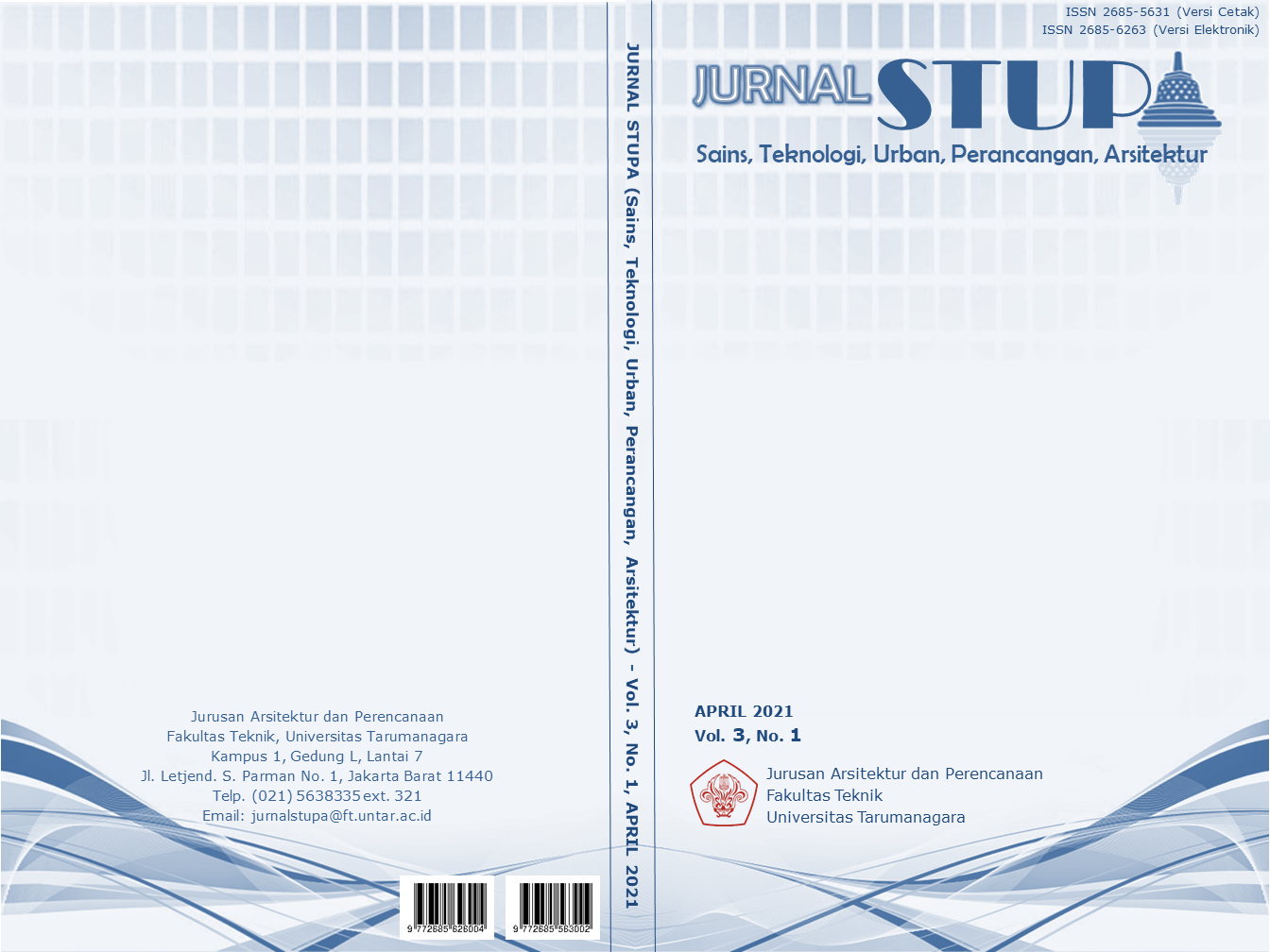RUMAH SINGGAH KOMUNITAS LANSIA DI BOGOR
Main Article Content
Abstract
The occurrence of the aging population phenomenon in the future between 2030-2050 will result in the domination of the elderly population in the world, which is caused by the phenomenon of baby boomers that occurred in the 1960-70s where birth rates and dependence rates were very high. Elderly is the peak of the last cycle in human life so that the aging process will occur which is marked by a decrease in physical and psychological functions. This decline can be overcome by meeting the needs of the elderly such as the ability to be mobile, community and the most important thing is health. The development of times and the flow of globalization require people to be able to survive in all conditions. However, the busyness of their children at work is often the impact of the physical and psychological conditions of the elderly, which in the process of aging require more attention. In Indonesia, there are already many nursing homes where the elderly live. However, the social structure in Indonesia is not used to the trend of elderly people living separately from their families and homes. Therefore, the project of the Halfway House for the Elderly in Bogor can become a new place that can accommodate the needs of the elderly to get attention to their aging condition without having to leave their home and family. The Halfway House provides rooms that can be occupied periodically after attending seminars and therapy activities. Facilities such as entertainment, fitness, animal therapy, environmental therapy are available to apply the concept through the retreat, recharge and reborn stages so that they can become productive and be active for the elderly community.
Keywords: health; community; elderly; aging; halfway house
Abstrak
Terjadinya fenomena aging population pada tahun 2030-2050 mendatang dimana populasi lansia akan mendominasi muka bumi diakibatkan oleh adanya fenomena baby boomers yang terjadi pada tahun 1960-70an dimana angka kelahiran dan ketergantungan sangat tinggi. Lansia merupakan puncak siklus terakhir dalam kehidupan manusia sehingga akan terjadinya proses penuaan yang ditandai dengan penurunan fungsi fisik dan psikis. Penurunan tersebut dapat diatasi dengan pemenuhan kebutuhan terhadap lansia seperti kemampuan untuk bermobilitas, berkomunitas dan hal yang terpenting adalah kesehatan. Berkembangnya zaman dan arus globalisasi menuntut masyarakat untuk dapat bertahan hidup dalam segala kondisi. Namun, kesibukan anak untuk bekerja seringkali menjadi dampak kondisi fisik dan psikis lansia yang dalam proses penuaannya membutuhkan perhatian lebih. Di Indonesia, sudah terdapat banyak panti jompo yang menjadi tempat tinggal kaum lansia. Akan tetapi, struktur masyarakat di Indonesia kurang menyukai dan tidak terbiasa apabila lansia harus tinggal secara terpisah dari keluarga dan rumah mereka. Oleh karena itu, proyek Rumah Singgah Komunitas Lansia di Bogor ini dapat menjadi tempat baru yang dapat mewadahi kebutuhan lansia untuk mendapatkan perhatian pada kondisi penuaan mereka tanpa harus meninggalkan rumah dan keluarganya. Rumah singgah ini menyediakan unit kamar yang dapat dihuni secara periodik tertentu setelah mengikuti seminar, dan kegiatan terapi. Fasilitas-fasilitas seperti hiburan, kebugaran, terapi hewan, terapi lingkungan yang tersedia diterapkan untuk mewujudkan konsep benih melalui tahapan retreat, recharge dan reborn sehingga dapat menjadi rumah singgah yang produktif dan aktif bagi komunitas lansia.
Article Details
References
Boentoro, H. & Dwi, A. (2016). Pandi Werdha di Batu, Jawa timur. JURNAL eDIMENSI ARSITEKTUR Universitas Kristen Petra, 4(2), 257-264.
Cicilia. (2019). Rumah Produktif lanjut usia. Jurnal Online Mahasiswa Arsitekur Universitas Tanjungpura, 7(1), Halaman 396-397.
Clark, G., Amabile, M., & Postone, Z. (2019). Cities Alive: Designing for Ageing Communities [Electronic Version]. London: Arup.
Departemen Kesehatan Republik Indonesia. (2006). Batasan Pengelompokan Lansia. Jakarta: Kementerian Kesehatan Republik Indonesia
Heidegger, M. (1971). Poetry, Language, Thought. New York: Harper & Row.
Hermawati, I. (2015). Kajian Tentang Kota Ramah Lanjut Usia. Jakarta: Kementrian Sosial Republik Indonesia
Keputusan Menteri Pekerjaan Umum Republik Indonesia. (1998). Persyaratan Teknis Aksesibilitas Pada Bangunan Umum dan Lingkungan, Jakarta: Kementerian Pekerjaan Umum Republik Indonesia
Kiik, S. M., Sahar, J & Permatasari. H. (2018). Peningkatan Kualitas Hidup Lansia di Kota Depok dengan Latihan Keseimbangan. Jurnal Keperawatan Indonesia, 21(2), 109-116.
Levebvre, H., & Levich, C. (1987). The Everyday and Everydayness. Yale French Studies 73: 7–11.
Maslow, A. H. (1943). A Theory of Human Motivation. Psychological Review 50(4), 370–396.
Murniyati, N. (2014). Pengaruh Terapi Lingkungan : Berkebun Terhadap Peningkatan Harga Diri Pasien Harga Diri Rendah di RSUD Banyumas.
Norberg-Schulz, C. (1985). The Concept of Dwelling on the Way to Figurative Architecture. Rizzoli International Publications.
Peraturan Menteri Kesehatan Republik Indonesia. (2016). Persyaratan Teknis Bangunan dan Prasarana Rumah Sakit. Jakarta: Kementerian Kesehatan Republik Indonesia.
Silawane, P. R., (2018). Rumah Sehat Lansia Kota Pontianak Provinsi Kalimantan Barat. Jurnal Online Mahasiswa Arsitektur Universitas Tanjungpura, 6(1), Halaman 257-260.
World Health Organization. (?2002)?. Active ageing : A Policy Framework. World Health Organization.



